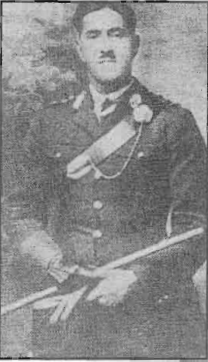1941 Iraqi coup d'état
| 1941 Iraqi coup d'état | |||||||
|---|---|---|---|---|---|---|---|
| Part of World War II | |||||||
 Coup leader Salah al-Din al-Sabbagh in 1930 | |||||||
| |||||||
| Belligerents | |||||||
|
Supported by: |
Supported by: | ||||||
| Commanders and leaders | |||||||
|
Prime Minister of Iraq |
3rd Division Commander 1st Division Commander Independent Mechanized Brigade Commander Chief of the Air Force | ||||||
| Units involved | |||||||
| Royal Guard |
3rd Infantry Division 1st Infantry Division Independent Mechanized Brigade | ||||||
The 1941 Iraqi coup d'état (
The coup was led by four
The coup
From 1939 to 1941 a pro-British government headed by the
The Golden Square coup was launched on 1 April 1941,[1] overthrowing the Regent and installing Rashid Ali al-Gaylani as Prime Minister.
On 2 May of the same year, Prime Minister Taha al-Hashimi was forced to resign after the conspirators surrounded the Royal Palace in Baghdad.[3]
British response
Empire forces sent to quell the revolt
On 18 April, Britain reacted by landing the
Siege of Habbaniya
In the following days, the new Iraqi government moved substantial ground forces, including an infantry brigade, an artillery brigade, and 12 armoured cars as well as tanks[4] to the plateau overlooking RAF Habbaniya, the large British Royal Air Force (RAF) base beside the River Euphrates 50 miles (80 km) west of Baghdad. Upon arrival, the Iraqis demanded that the British not move any troops nor aircraft in or out of the base. The British responded by first demanding that the Iraqis leave the area and then, following the expiry of an ultimatum given in the early hours of 2 May, launched an attack. The base had a force of 96 lightly-armed aircraft, most of which were either purpose-built trainers or obsolete combat aircraft converted to training use. They also had an understrength battalion from the King's Own Royal Regiment (Lancaster), six companies of Assyrian Levies (troops raised by the British), 18 armoured cars and a company of RAF personnel, giving a total strength of 2,200 troops to defend the base.[5] The Royal Iraqi Air Force, despite having aircraft that included numerous modern British-, Italian- and US-built machines, failed to defeat the RAF. By the second day of fighting (3 May), four Blenheim fighter bombers arrived.[6]
With British forces having air superiority, the Iraqi army was forced back to Fallujah and the RAF attacked the Iraqi Air Force bases at Mosul and Rashid. Habbaniya had essentially lifted the siege with its own resources.
Reinforcements, officially called "Iraqforce", came from two directions. British and Arab Legion forces arrived in two columns (Habforce and Kingcol) across the desert from Palestine and Transjordan. Additional Indian forces continued to arrive in Basra.[5]
The Iraqi army was driven out of Fallujah and pursued to Baghdad, which fell within a week. This cleared the way for the nominal restoration of the Regent and the pro-British government. British military occupation of Iraq continued until late 1947.
German and Italian support for the nationalists
In the course of the Iraq war, minor reinforcements for the nationalists were received from first Germany and then Italy. Arriving aircraft were crudely painted with Iraqi colours. Small numbers of Luftwaffe (German air force) bombers and heavy fighters, followed a few days later by obsolescent Regia Aeronautica (Italian air force) biplane fighters, flew sorties from Mosul against both RAF Habbaniya and the relieving Empire forces moving across from Transjordan. This was done to little effect.
The
See also
- 14 July Revolution
- Airspeed Oxford
- Fairey Gordon
- Farhud
- Fawzi al-Qawuqji
- Führer Directive No. 30
- Gloster Gladiator
- Hawker Audax
- King's Own Royal Regiment (Lancaster)
- Vickers Type 264 Valentia
- Vickers Wellington
References
- ^ a b c Scott, James C (9 August 2001). "The Coup". Iraqi Coup. California State University, Sacramento. Archived from the original on 24 October 2007.
- ^ Ehrlich, Sarah (1 June 2011). "Farhud memories: Baghdad's 1941 slaughter of the Jews". BBC.
- ^ "ثورة رشيد عالي الكيلاني". المعرفة (in Arabic). Retrieved 2023-07-28.
- ^ Kiwarkis, Gabriel. "The Battle for Habbaniya 1941". Assyrian RAF Levies.
- ^ a b "The Battle for Habbaniya – The forgotten war RAF". History (Campaign Histories). Royal Air Force. Archived from the original on June 7, 2008.
- ^ "History Section". Royal Air Force. Archived from the original on March 30, 2008.
Sources
- Faber and Faber.
- Dudgeon, Anthony G (2000). Hidden Victory: The Battle of Habbaniya, May 1941. Stroud and Charleston: ISBN 0-7524-2001-1.
- "The Battle for Habbaniya – The forgotten war RAF". History (Campaign Histories). Royal Air Force. Archived from the original on June 7, 2008.
- Dunford Wood, Colin (2 June 2011). "Habbaniya Campaign, Iraq 1941". A Story of War. – an RAF pupil pilot's diary of the Habbaniya campaign
- Dunford Wood, Colin (4 March 2012). "RAF Habbaniya Daily Intelligence Bulletins". A Story of War.
External links
- "Near East: Trouble in Paradise". Time. 21 April 1941. Archived from the original on June 24, 2010. Retrieved 15 July 2009.
- "May 12 – U.S.S.R. recognizes pro-Nazi Government of Iraq". Time. 30 June 1941. Archived from the original on April 13, 2008. Retrieved 5 July 2009.
